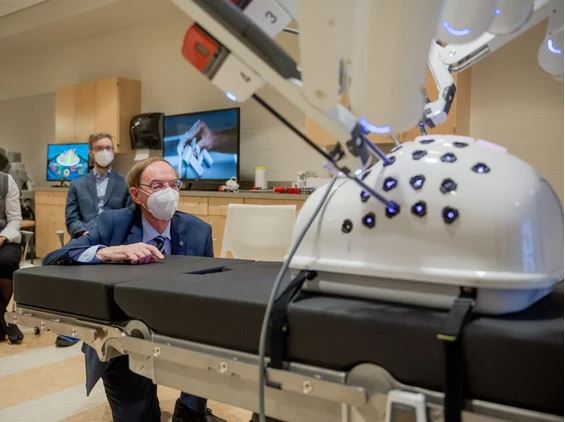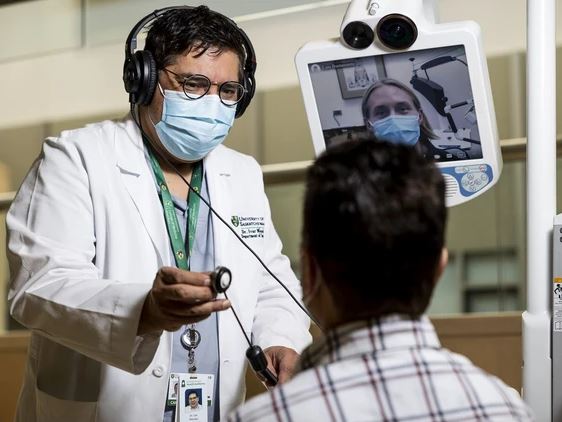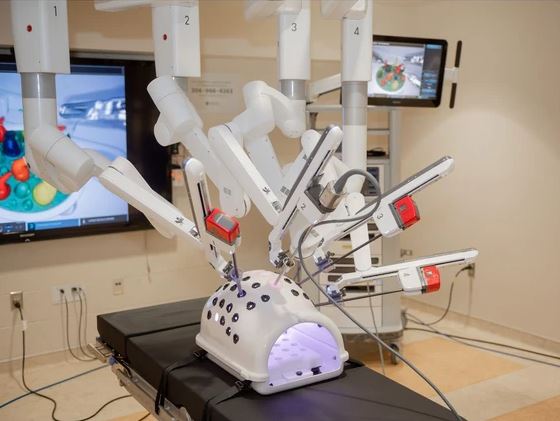
Saskatchewan's new robotic surgery system brings it to cutting edge
“It is the natural evolution of technology. You don’t use a paper map to navigate a city. You use GPS. It is the same with surgery."
By Zak Vescera | Saskatoon StarPhoenixFive years ago, Dr. Peter Spafford (MD'87) thought bringing a robotic surgery system to Saskatchewan was “a long-shot or a no-shot.”
But the head-and-neck surgeon’s dream came true after doctors, philanthropists and the government teamed up to buy a multi-million-dollar surgical system to put Saskatchewan on the cutting edge of surgery.
Provincial surgery head Dr. Ivar Mendez said the purchase of the Da Vinci surgery system, which will cost about $2.5 million, will mark the inception of a new surgical robotics program in Saskatchewan that promises to attract top talent and improve care for patients.
“It is the natural evolution of technology. You don’t use a paper map to navigate a city. You use GPS. It is the same with surgery,” Mendez said in an interview with the Saskatoon StarPhoenix.

Surgeons have eyed buying such a system for years, but the province and the St. Paul’s Hospital Foundation were able to start procurement well ahead of schedule thanks to a $1 million donation from the family of philanthropist Merlis Belsher, who are also agreeing to match up to $100,000 in donations to the foundation.
The provincial government is paying the remaining $1 million in capital costs, plus operating expenses.
According to the province, the targeted timeline for the first robot-assisted procedure to be performed is the fall of 2022.
The system’s long, robotic limbs allow surgeons to perform complex procedures without large incisions, Mendez said.
Surgeons operate the robot through a nearby console, meaning a trained human is still conducting the surgery, but the robot’s “little hands” do not shake and can fit through small punctures in the body. Those smaller incisions mean patients recover faster. That, in turn, means hospital beds can open up quicker, which means surgeons can perform more procedures.
Its small hands also mean it can operate on parts of the throat, abdomen and pelvis that surgeons have a hard time reaching.

“The patients just do way better. They’re in the hospital for much shorter times. Their pain is much less,” Dr. Varunkumar Bathini (MD'09) said.
The Saskatoon urologist, who was trained in using such systems during his residency, said they’re becoming increasingly standard in Canada. Getting a robot is key to attracting good surgeons to Saskatchewan.
“I was always that crazy surgeon in the operating room saying, ‘Hey, when are we getting that robot?’ ” Bathini said with a laugh.
The robot will likely be used for a handful of specialties at first, but Bathini imagines more and more surgeons will be trained in it over time. A business plan projects the robot could perform 220 surgeries a year by the end of a five-year ramp-up.

“It will go a long way in recruiting and attracting surgeons to our province, which we always know is front of mind,” said St. Paul’s Hospital Foundation CEO Lecina Hicke.
The government agreed to pay up to $1 million to fund the purchase, and will cover annual operating expenses which are estimated at $160,000 in the first year and almost $800,000 by the end of the ramp-up. That left St. Paul’s Hospital Foundation committing to raise more than $1.5 million.
A series of fortunate events brought Merlis Belsher (BComm'57, LLB'63, LLD'18) into the picture.
Belsher and Spafford met while raising money for a new hockey arena at the U of S, which now bears Belsher’s name. Spafford was a former Huskie hockey player, and he and Belsher eventually forged a friendship.
Later, Belsher would become his patient after developing cancer in his mouth. At one point, Spafford mentioned the robot; he worried the combo of government deficits and the COVID-19 pandemic put the project out of reach.
One day, Belsher was speaking with Hicke over the phone, and she mentioned the project. Belsher put two and two together.
“It’s like it was meant to be,” he said.

Hicke said the gift from the Belsher family will have a long-lasting and wide-ranging impact.
Read the full story at https://thestarphoenix.com.

